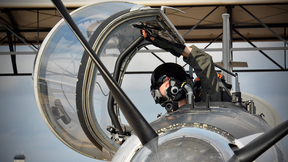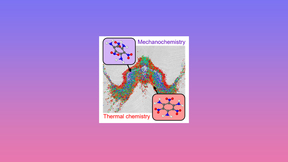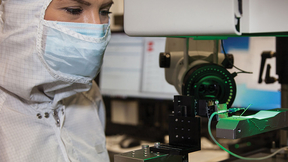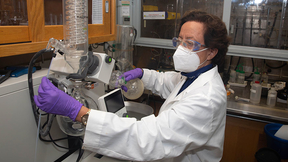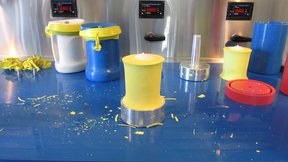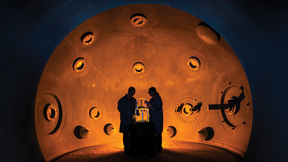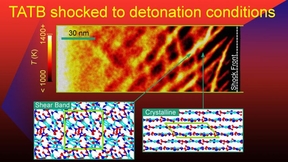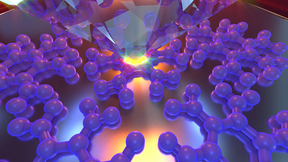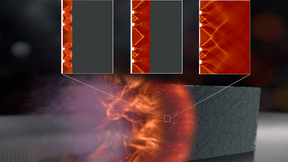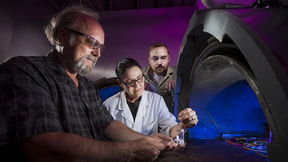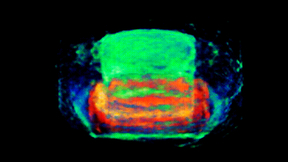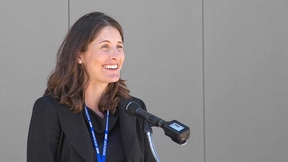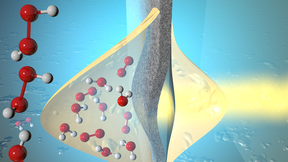Back
Energetic Materials Center
Simulating hot-spot formation in insensitive high explosives
When high explosives are subjected to sudden shock waves, such as from an impact or detonation, tiny regions of intense heat — called hot spots — form at microstructural defects such as pores. These hot spots play a critical role in determining whether the explosive will initiate and fully detonate. Understanding how hot spots form and behave across length scales is key to…
Probing deflagration to better understand detonation
Suddenly, there’s a flash of intense light and heat, followed by a rapidly expanding fireball. Combustion of high explosives is everywhere in popular culture, and it's also critical for ensuring the safety and reliability of the U.S. stockpile. While detonations often get all the credit in combustion, deflagrations — their subsonic, less famous precursors — are also…
New program aims to fast-track energetic materials education for researchers
More than 80 physicists, chemists, material scientists and engineers participated in a new educational program at Lawrence Livermore National Laboratory (LLNL) during 2024, developed and delivered by the Lab’s energetic materials experts. As hiring at LLNL accelerated in recent years, Lab leaders recognized the growing need to provide specialized training for newer members…
Manufacturing optimized designs for high explosives
When materials are subjected to extreme environments, they face the risk of mixing together. This mixing may result in hydrodynamic instabilities, yielding undesirable side effects. Such instabilities present a grand challenge across multiple disciplines, especially in astrophysics, combustion and shaped charges — a device used to focus the energy of a detonating explosive…
Beating the odds: Former Energetic Materials Center intern named U.S. Air Force Cadet of the Year
Second Lt. Hannah Fletcher, a 2021 Lawrence Livermore National Laboratory (LLNL) Reserve Officer Training Corps (ROTC) summer intern, has been named the 2022 United States Air Force (USAF) Cadet of the Year. This award recognizes the best cadet in an Air Force commissioning program based on military performance, academics and physical fitness. LLNL’s ROTC internship…
Research finds mechanically driven chemistry accelerates reactions in explosives
Scientists at the Lawrence Livermore National Laboratory (LLNL) Energetic Materials Center and Purdue University Materials Engineering Department used simulations performed on the LLNL supercomputer Quartz to uncover a general mechanism that accelerates chemistry in detonating explosives critical to managing the nation’s nuclear stockpile. Their research is featured in the…
A Shot Like No Other
Lawrence Livermore National Laboratory researchers aligned energetic materials knowledge and high-energy-density science expertise with experimental capabilities at the world’s most energetic laser, the National Ignition Facility.
Playing it safe: LLNL scientist creates energetic compounds with isotopic labels
Ana Racoveanu is able to do something most others throughout the nuclear security enterprise cannot do — something challenging and extremely valuable throughout the complex. Racoveanu, a staff scientist in Lawrence Livermore National Laboratory’s Materials Science Division, is able to synthesize energetic compounds with isotopic labels. The primary goal of this work is to…
Lawrence Livermore’s pressing operations with high explosives reach new milestones
High explosive (HE) research, development, test and evaluation work at Lawrence Livermore National Laboratory (LLNL) continues to meet the needs of the nation on behalf of the National Nuclear Security Administration (NNSA). One specific effort is the HE pressing capability, which is a critical component of the LLNL’s national security mission. The scope of the Lab’s HE…
Three Decades of Explosive Innovation
Since Lawrence Livermore’s inception in 1952, Laboratory researchers have been among the nation’s leaders in understanding, synthesizing, formulating, testing, assessing, and modeling the initiation systems and energetic materials (EM) that play an integral role in the U.S. nuclear deterrent, conventional munitions, and homeland security. The Laboratory’s Energetic…
Research uncovers missing physics in explosive hotspots
Research conducted on Lawrence Livermore National Laboratory’s (LLNL) supercomputer Quartz highlights findings made by scientists that reveal a missing aspect of the physics of hotspots in TATB (1,3,5-trimamino-2,4,6-trinitrobenzene) and other explosives. Hotspots are localized regions of elevated temperature that form from shock-induced collapse of microstructural…
NIF conducts first-ever shot with explosives
The first-ever shot to study a high explosive sample was recently conducted at the National Ignition Facility (NIF), the world’s most energetic laser. The results from the shot included novel data that will help researchers unlock the mysteries of high-explosive (HE) chemistry and position Lawrence Livermore National Laboratory (LLNL) to continue its legacy as a leader in…
Simulations explain detonation properties in TATB
Two Lawrence Livermore National Laboratory (LLNL) scientists have discovered a new mechanism for ignition of high explosives that explains the unusual detonation properties of 1,3,5-triamino-2,4,6-trinitrobenzene (TATB). The research will allow for systematic improvements to continuum mechanics models used to assess the performance and safety of the material accurately and…
Researchers discover an unexpected phase transition in the high explosive TATB
Lawrence Livermore National Laboratory (LLNL) scientists in collaboration with University of Nevada Las Vegas (UNLV) have discovered a previously unknown pressure induced phase transition for TATB that can help predict detonation performance and safety of the explosive. The research appears in the May 13 online edition of the Applied Physics Letters and it is highlighted…
Uncovering secret structure to safer explosives
A team of scientists at Lawrence Livermore National Laboratory (LLNL) has shown that the structure of microscopic pores in high explosive materials can significantly impact performance and safety. These findings -- published recently as the cover article in the journal Propellants, Explosives, Pyrotechnics -- open the door to the possibility of tuning high explosives by…
Detonation Science Blasts into a New Frontier
At Lawrence Livermore, a key aspect of stockpile stewardship includes fine-tuning and experimentally observing HE detonation processes and developing computer models to predict the behavior of different HEs. Over the last several decades, HE detonation science has progressed toward higher resolution experimental and modeling capabilities that explore initiation processes,…
It's a blast: Imaging high explosive detonators
Lawrence Livermore National Laboratory (LLNL) scientists and collaborators at Los Alamos National Laboratory (LANL) for the first time have taken 3D snapshots of operating high explosive detonators. Scientists from LLNL, Los Alamos and National Security Technologies, LLC (NSTech) combined state-of-the-art imaging capabilities with computed tomographic reconstruction (X-ray…
Thermite Research Heats Up
Energetic materials—explosives, propellants, and pyrotechnics—are substances that store and release large amounts of chemical energy. They are made by either physically mixing solid oxidizers and fuels to produce a composite energetic material, such as gunpowder, or by creating a molecule that contains both oxidizing and fuel components, such as TNT.
Lara Leininger named director of Laboratory's Energetic Materials Center
Lara Leininger has been selected to lead Lawrence Livermore National Laboratory’s (LLNL) Energetic Materials Center (EMC).Created 25 years ago, the EMC’s mission is to integrate state-of-the-art capabilities in high explosives, propellants, thermites and pyrotechnics for the benefit of the Stockpile Stewardship Program and other National Nuclear Security Administration…
Smashing science: Livermore scientists discover how explosives respond to shockwaves
Lawrence Livermore National Laboratory researchers have combined ultrafast time-resolved experimental measurements with theory to reveal how an explosive responds to a high-impact shock.The work involved advances in both ultrafast experimental shock wave methods and molecular dynamics (MD) simulation techniques, and the combination of experiment and simulation is a…






